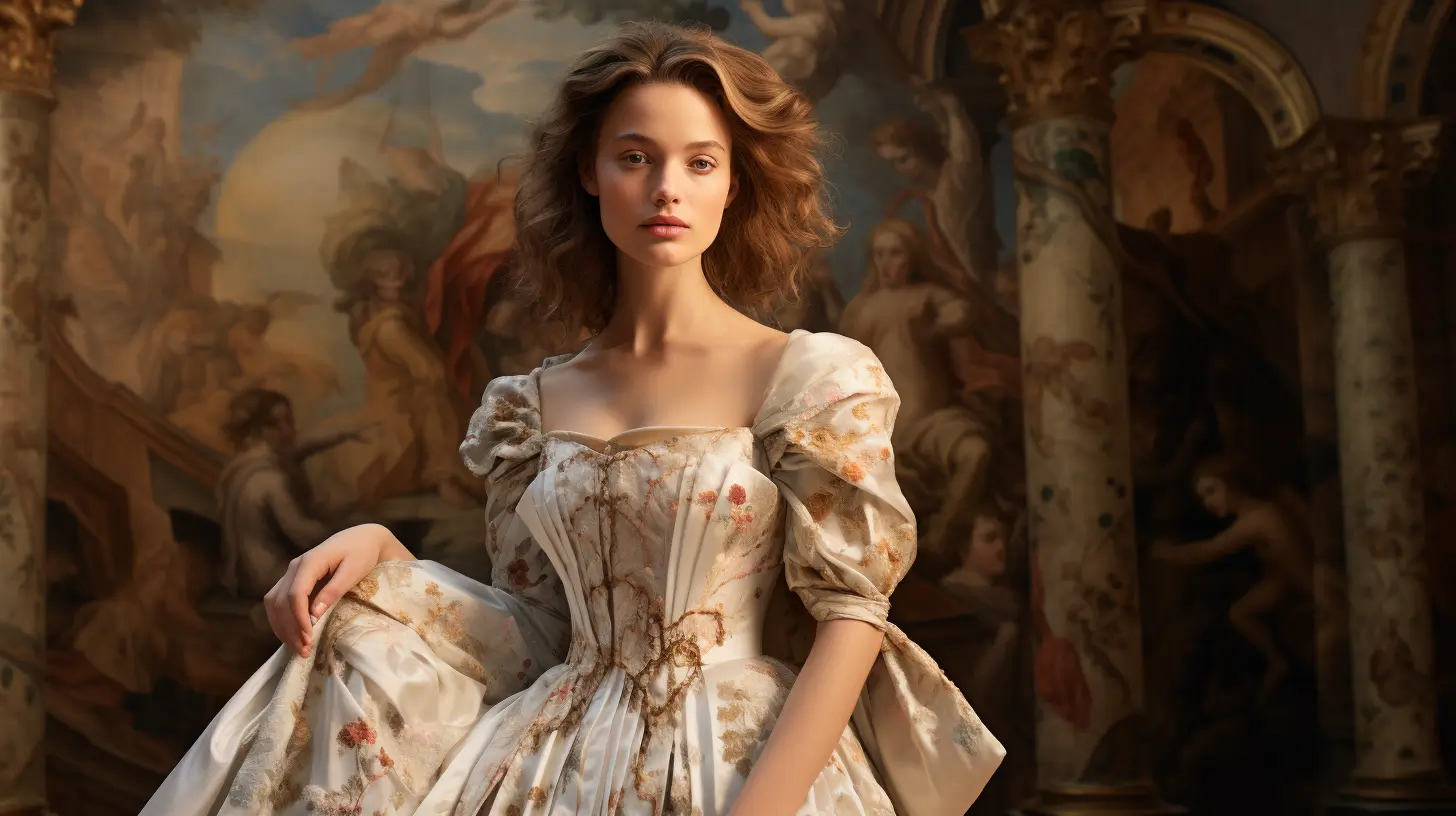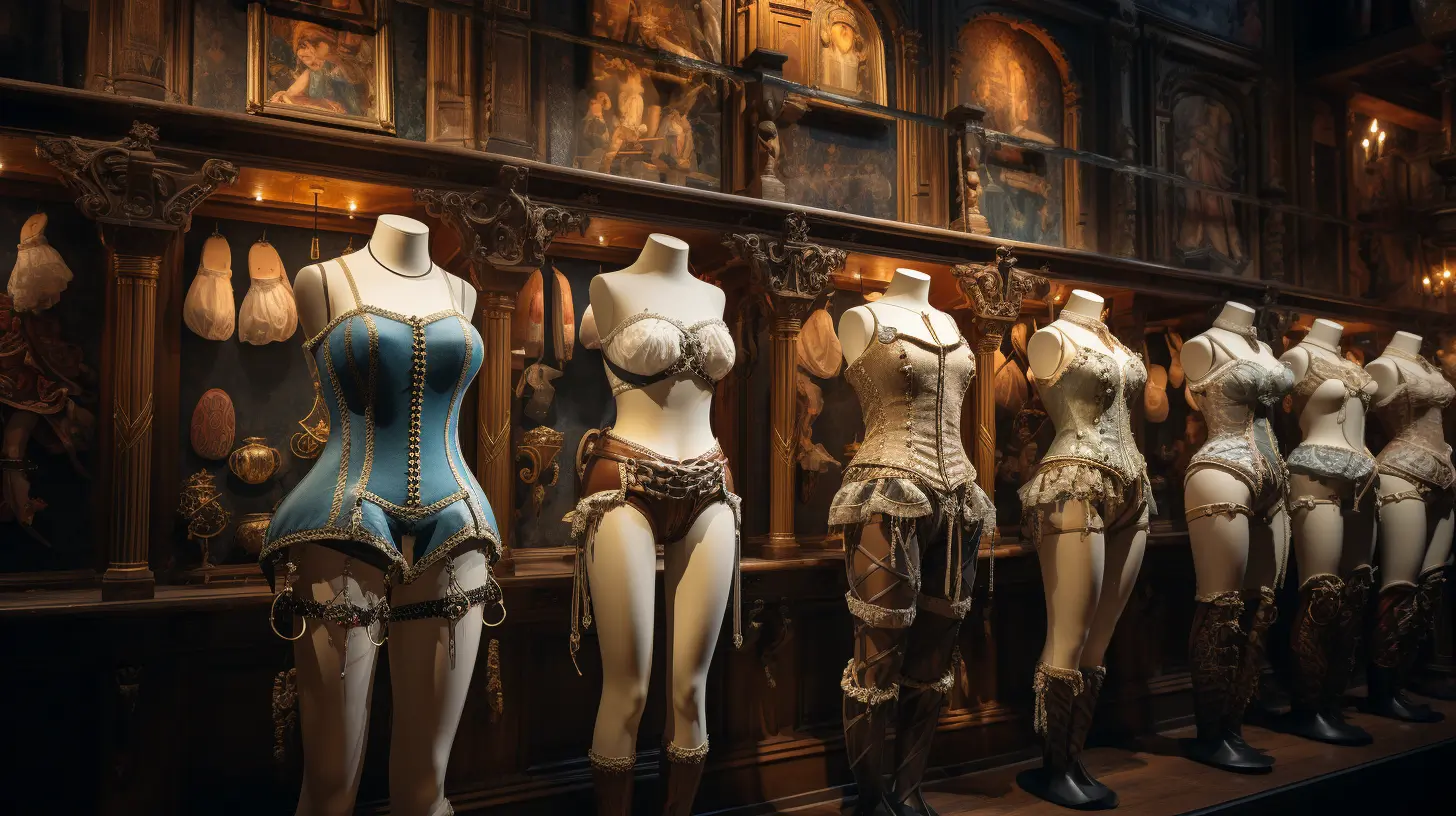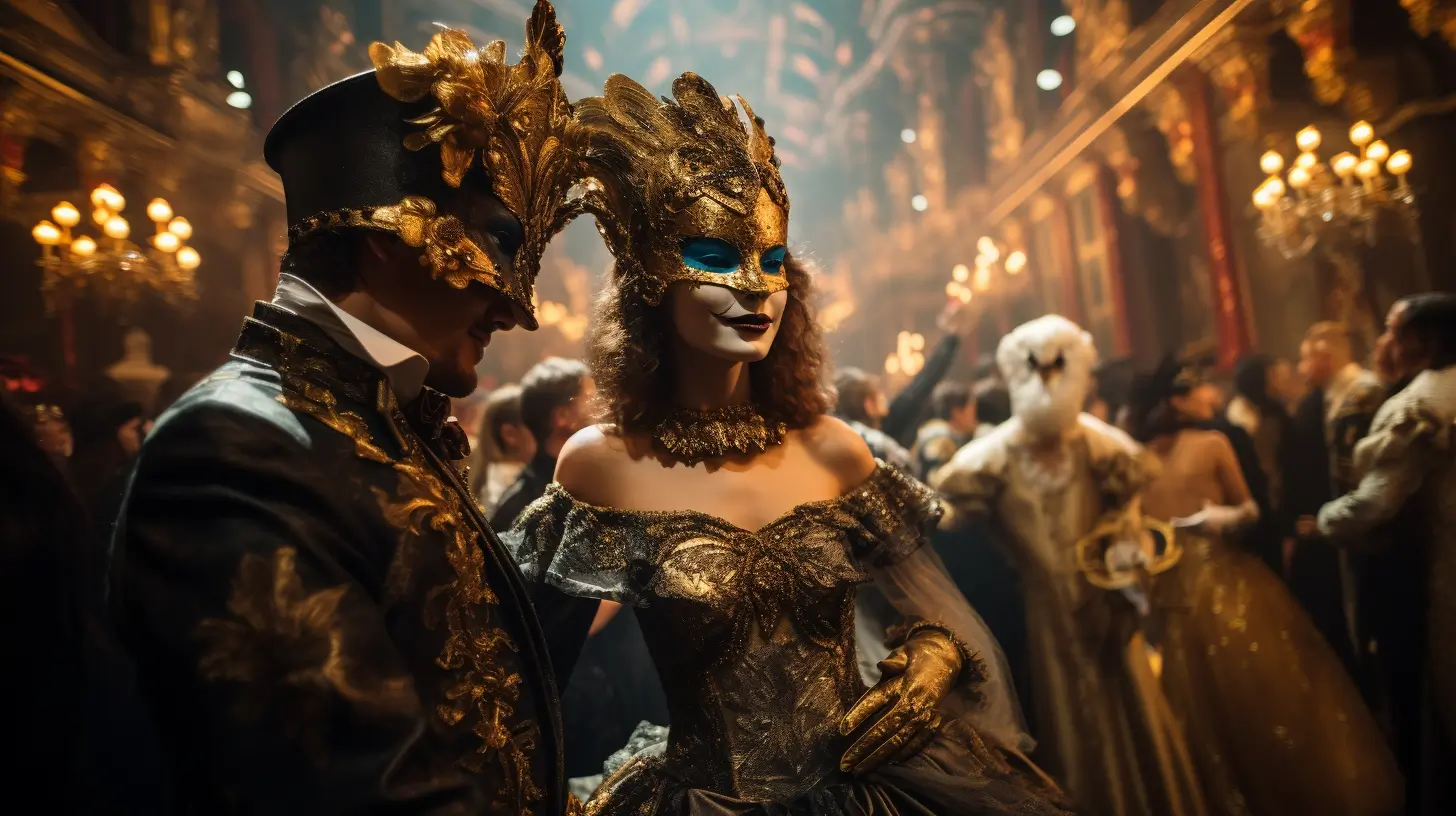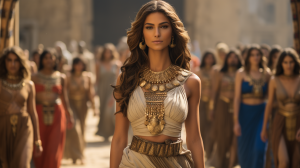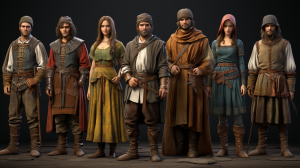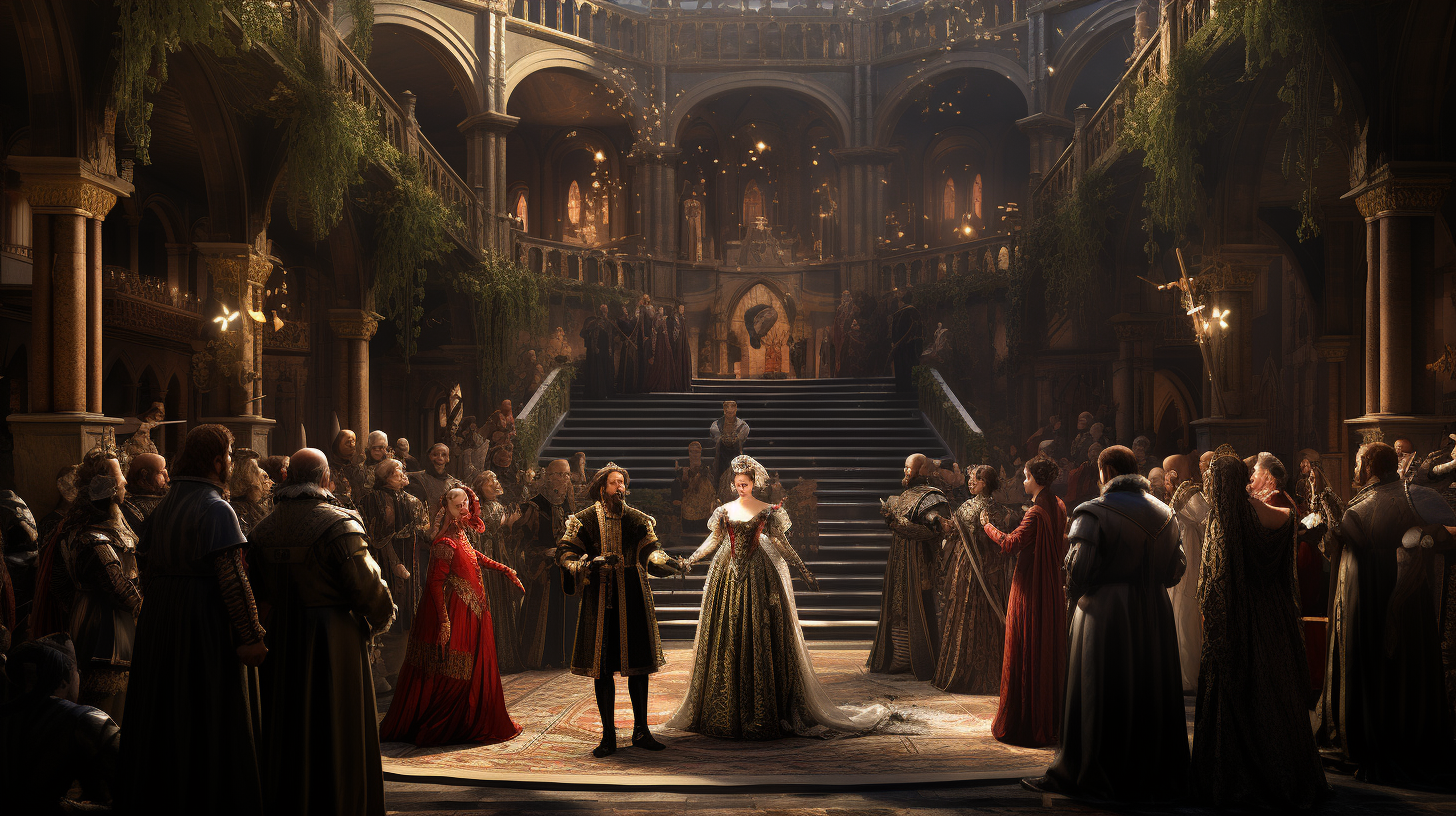
🌟 A Journey Through the Luxurious Fabrics of the Renaissance 🌟
Ladies and gentlemen, fashion enthusiasts, and curious minds, welcome to a captivating journey through the annals of time—a journey that transcends mere chronology and plunges us deep into the heart of a bygone era. In this virtual time machine, we shall embark on a mesmerizing expedition, guided by the threads of history, into the very essence of the Renaissance.
Picture, if you will, a time when artistry and craftsmanship flourished, when the world was reborn in a tapestry of colors and textures. Our focus for this immersive voyage is none other than the fabrics that defined an era of opulence, elegance, and artistic excellence—the Renaissance Fabrics.
As we delve into this rich tapestry of historical fashion, you’ll find that our journey is not a mere exploration of clothing but a voyage through the very soul of an age that redefined aesthetics and creativity. In the pages that follow, we shall uncover the secrets and stories behind the sumptuous fabrics that adorned the nobility and aristocracy of the Renaissance era.
So, let us set the stage for this odyssey—a journey that will lead us through the intricate patterns of velvet, the shimmering allure of silk, and the woven elegance of brocade. These fabrics, like the strokes of a masterful painting, were not merely worn; they were revered, celebrated, and cherished.
👑 The Renaissance Era Unveiled
🕰️ A Glimpse into Renaissance History
To truly appreciate the fabrics that graced the Renaissance, we must first step into the enigmatic past of this remarkable era. The Renaissance, which spanned roughly from the 14th to the 17th century, was a time of rebirth, innovation, and profound change. Emerging from the shadow of the Middle Ages, it marked a period of enlightenment and creativity in Europe.
🏰 Historical Context
Picture the grandeur of Renaissance Europe—the flourishing city-states of Italy, the resplendent courts of France, and the ever-evolving landscape of art and ideas. This was a time when the Medici family, patrons of the arts, held sway in Florence, and Leonardo da Vinci’s genius graced the world. As we embark on our journey through Renaissance fabrics, we must understand this remarkable historical backdrop.
🌍 Cultural and Artistic Flourishing
The Renaissance was a cultural renaissance in the truest sense. Humanism, the belief in the potential of the individual, fueled the era’s intellectual pursuits. The revival of classical knowledge, combined with a newfound fascination with science and exploration, led to profound cultural changes. Art flourished, and a passion for aesthetics permeated every aspect of life, including fashion.
🎭 The Theater of Fashion
In Renaissance Europe, clothing was not just a necessity; it was a form of self-expression and artistry. The elite and nobility adorned themselves with sumptuous fabrics and extravagant garments. To truly appreciate the fabrics that defined this era, we must delve into the intricate stories woven into the very fabric of Renaissance life.
👑 Velvet – The Royal Fabric
🌟 The Opulent Origins of Velvet
Ladies and gentlemen, as we journey further into the heart of Renaissance fashion, our spotlight now falls upon the resplendent fabric known as velvet. Velvet, with its plush texture and regal appearance, reigned supreme in the wardrobes of Renaissance nobility. Let us delve into the opulent origins of this fabric.
In the late Middle Ages, velvet was a rare and coveted textile, woven with intricate techniques to create a soft pile that caught and reflected light like no other fabric of its time. Its origins can be traced to the Far East, where it was initially produced. The term “velvet” itself is believed to have been derived from the Middle French word “velu,” meaning “shaggy” or “hairy.” This description aptly captures the lush surface of this sumptuous fabric.
👑 Symbolism in Velvet
In Renaissance Europe, velvet was not merely a fabric; it was a symbol of wealth, power, and social status. Nobility and royalty draped themselves in garments crafted from the finest velvets, often adorned with intricate embroidery and embellishments. Velvet gowns, cloaks, and doublets became iconic symbols of the Renaissance aristocracy.
Velvet’s association with royalty was not accidental. Its deep, rich colors, and soft sheen were seen as reflections of the opulence and grandeur of the courts. Velvet garments, often embellished with precious gems and gold thread, were reserved for the most prestigious occasions, such as royal weddings and courtly ceremonies.
🧵 The Craftsmanship Behind Velvet
To truly appreciate velvet’s allure, one must understand the painstaking craftsmanship that went into its creation. Velvet is woven using a unique technique where two layers of fabric are woven simultaneously. The loops formed in this process are then cut, creating the characteristic soft pile. This intricate weaving method required skilled artisans who dedicated themselves to perfecting their craft.
As we journey further into the Renaissance era, imagine the workshops filled with weavers and dyers painstakingly creating these luxurious fabrics. Velvet was not just a fabric; it was a testament to the mastery of textile artisans who transformed raw silk into a textile fit for royalty.
🖼️ Visual Showcase
In this section, a carefully curated image would be a fitting addition to help readers envision the lush textures and opulent colors of Renaissance velvet. A placeholder for such an image can be inserted here.
👑 Silk – A Luxury Beyond Compare
🌐 The Silk Road: A Journey of Discovery
In the resplendent tapestry of Renaissance fashion, few fabrics could rival the prestige and allure of silk. As we continue our voyage through time, our focus now turns to this remarkable material—a luxury beyond compare in the Renaissance era.
Silk, often referred to as “the queen of textiles,” made its way to Europe through the ancient trade routes known as the Silk Road. This intricate network of interconnected pathways spanned thousands of miles, linking the East and West in a cultural exchange of unparalleled significance.
🌍 The East Meets the West
Silk’s journey to Europe began in the heart of Asia, where it was cultivated, woven, and dyed with meticulous care. The secrets of sericulture, the art of silk production, were closely guarded by the Chinese for centuries. In the Renaissance era, the coveted fabric began to flow into Europe, transported along this remarkable route.
Imagine the bustling marketplaces where traders from distant lands bartered their precious cargo. The exotic allure of silk, with its shimmering surface and vibrant colors, captivated the imaginations of European nobility and merchants alike. Silk garments soon became a symbol of wealth, sophistication, and worldliness.
💎 Silk’s Role in Trade and Diplomacy
Silk was not merely a luxurious fabric; it was also a currency of diplomacy and international relations. European monarchs and diplomats recognized the value of silk as a diplomatic gift, a token of goodwill, and a means of forging alliances.
Intricately woven silk textiles were presented as gifts between European courts and foreign powers, symbolizing not only the elegance of the giver but also the strength of their alliances. The exchange of silk between nations served as a testament to the fabric’s cultural significance in the Renaissance world.
👗 Exquisite Examples of Silk Garments
Our journey through the world of silk would be incomplete without a visual feast of the exquisite garments that graced the Renaissance elite. Imagine a Renaissance court, where ladies draped in flowing silk gowns adorned with intricate lace and gentlemen in silk doublets and breeches danced and conversed. The richness and diversity of silk patterns and colors were a sight to behold.
In this section, I recommend including a carefully selected image showcasing a remarkable Renaissance silk garment. The image will serve as a visual reference for readers, allowing them to appreciate the intricate details and craftsmanship that defined silk fashion in the Renaissance.
👑 Brocade – Woven Elegance
✨ The Artistry of Brocade
Ladies and gentlemen, as we continue our voyage through the Renaissance’s rich fabric tapestry, we arrive at the exquisite realm of brocade. Brocade, with its intricate patterns and woven elegance, held a special place in the hearts and wardrobes of the Renaissance elite. Join me as we unravel the artistry of this remarkable fabric.
🧵 The Definition and Characteristics of Brocade
Brocade is more than just a fabric; it is a masterpiece of weaving artistry. Characterized by its raised patterns, brocade is created by weaving with an additional weft thread, which adds a raised texture to the surface. The result is a fabric adorned with intricate designs, often featuring floral motifs, animals, or scenes from mythology.
Imagine the looms of Renaissance weavers at work, meticulously crafting brocade textiles fit for kings and queens. The rich, tactile surface of brocade garments captured the imagination and hearts of those fortunate enough to wear them.
🎨 The Intricate Art of Brocade Weaving
To truly appreciate brocade, we must delve into the meticulous art of its weaving. Unlike other textiles of the time, brocade required a high level of skill and precision. Weavers used drawlooms, a complex and labor-intensive tool, to create the intricate patterns.
As the weaver manipulated the threads, the loom produced the mesmerizing designs that adorned brocade fabrics. The process was time-consuming and demanded unwavering attention to detail, making brocade a symbol of dedication to the craft.
👑 Brocade’s Popularity Among the Elite
Brocade’s extraordinary beauty made it a highly sought-after fabric among the Renaissance elite. The rich patterns and vibrant colors of brocade garments added a sense of opulence and luxury to courtly attire. Nobles and aristocrats prized brocade gowns, doublets, and cloaks, often reserving them for grand events and special occasions.
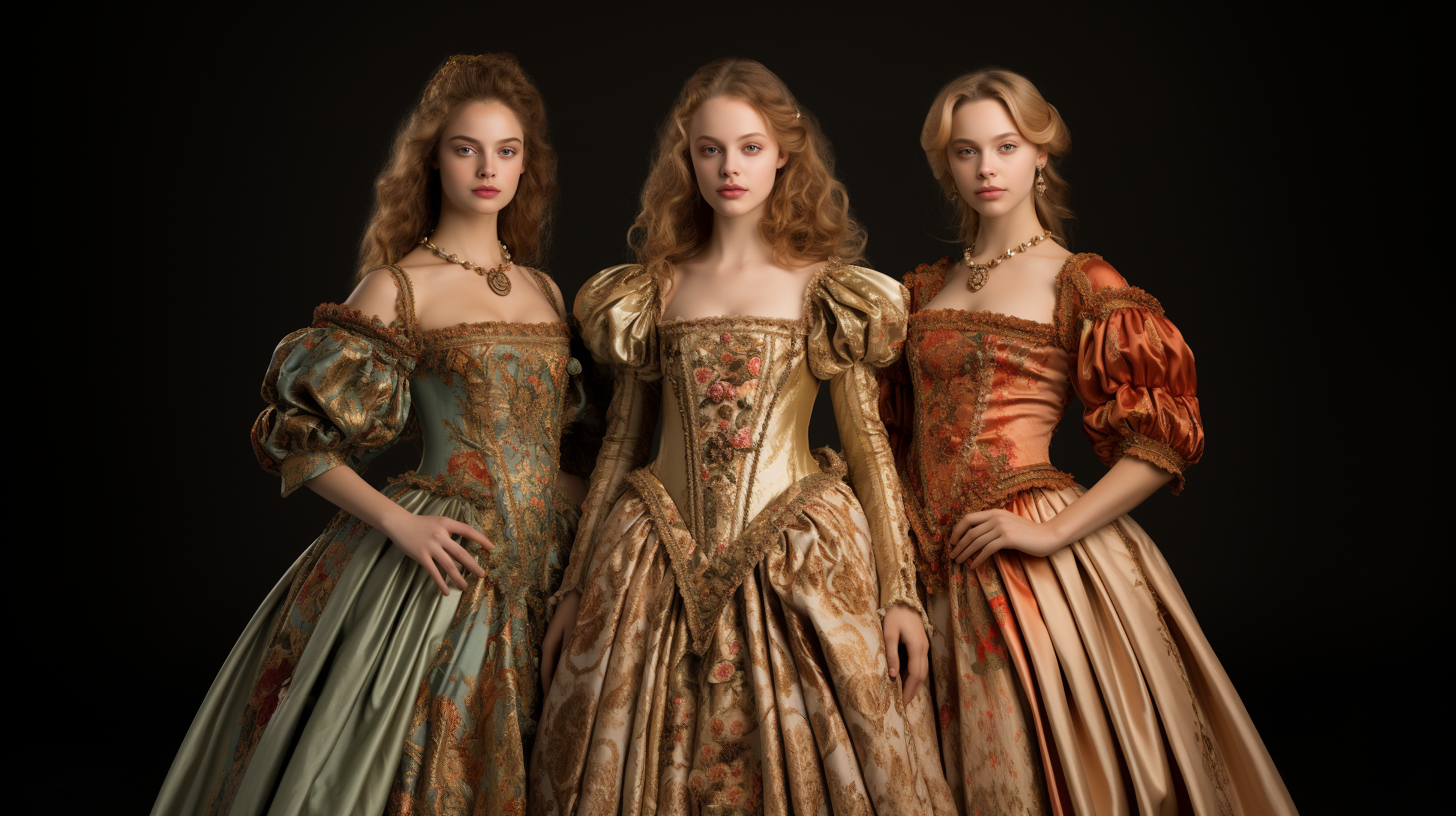
a Renaissance court adorned in the resplendent hues and designs of
brocade, each garment a testament to the wearer’s social standing and
appreciation for the art of fashion. Brocade’s popularity reached
its zenith during this era, and its influence on Renaissance style cannot
be overstated.
👗 Notable Brocade Garments and Their Designs
In this section, I recommend showcasing a carefully chosen image of a notable Renaissance brocade garment. This visual reference will allow readers to witness the intricate designs and exquisite craftsmanship that made brocade a hallmark of Renaissance fashion.
👑 Fashioning the Nobility
👑 The Regal Attire of Renaissance Nobility
In the grand courts and lavish palaces of Renaissance Europe, fashion was not merely a matter of personal style; it was a reflection of social standing and power. The sumptuous fabrics we have explored thus far—velvet, silk, and brocade—played a pivotal role in shaping the clothing of the Renaissance nobility.
🌟 Expressions of Status and Prestige
Picture, if you will, the grandeur of a Renaissance court, where nobles and aristocrats showcased their affluence and prestige through their attire. The choice of fabric, color, and design held profound significance, with each garment serving as a statement of one’s social status.
👗 Elaborate Descriptions of Renaissance Clothing Styles and Silhouettes
To understand the impact of these fabrics, one must delve into the world of Renaissance clothing styles and silhouettes. The Renaissance was marked by an array of distinctive fashion elements, each contributing to the overall opulence and grandeur of attire.
For men, doublets and hose tailored from luxurious fabrics like velvet were favored, often paired with elaborately ruffled collars and cuffs. Women, on the other hand, donned sumptuous gowns with fitted bodices and voluminous skirts. The farthingale, a hoop skirt, was employed to create the fashionable silhouette of the era.
💃 The Role of Fabrics in Silhouettes
Silk and brocade gowns flowed gracefully, cascading like waterfalls, while velvet doublets created an air of regal authority. The choice of fabric was intrinsically linked to the desired silhouette. Velvet, with its weight and structure, was ideal for creating the stiff, upright appearance of men’s attire, while silk and brocade lent themselves beautifully to the flowing, graceful lines of women’s gowns.
🖼️ Visual Showcase
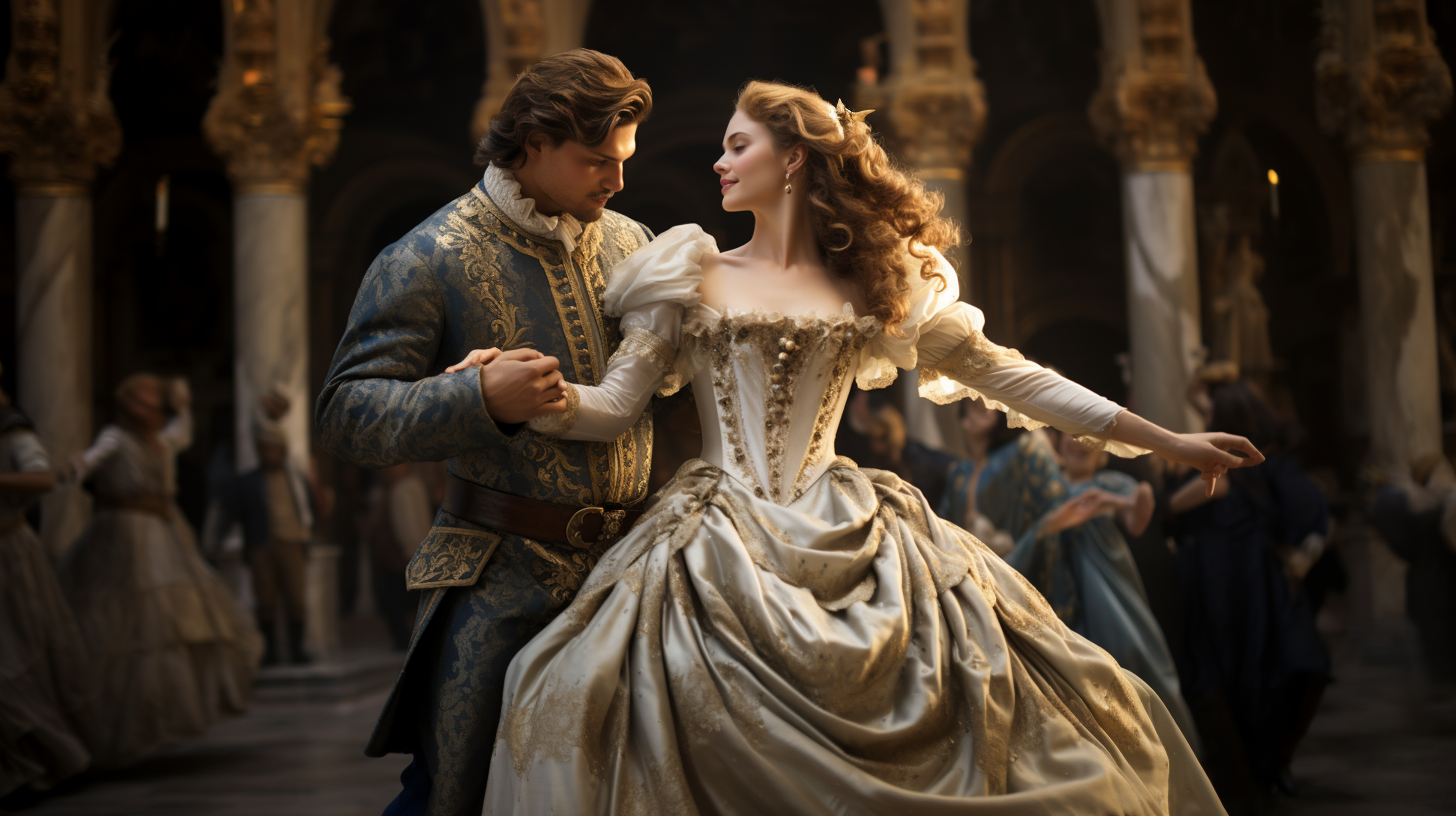
👑 Artistry and Craftsmanship
🧵 The Meticulous Art of Renaissance Tailoring
In the world of Renaissance fashion, every garment was a masterpiece of artistry and craftsmanship. Tailors of the era were more than mere clothiers; they were artists who sculpted fabric into garments that epitomized elegance and precision.
🌟 The Role of Tailors in Renaissance Society
Picture, if you will, a Renaissance tailor’s workshop—a place where bolts of sumptuous fabrics like velvet, silk, and brocade awaited transformation into exquisite garments. Tailors were the unsung heroes of the era, responsible for translating the visions of the elite into tangible works of art.
These skilled artisans possessed an intimate knowledge of fabrics, patterns, and the human form. Their craft was a symphony of precision, where every stitch and seam was meticulously executed. The tailor’s art was not merely about creating clothing; it was about elevating the wearer to a higher plane of elegance.
🪡 The Art of Embroidery and Embellishment
To truly appreciate Renaissance fashion, we must also explore the art of embroidery and embellishment. In an age when opulence was paramount, garments were often adorned with intricate patterns and designs created with silk thread, precious gems, and even gold and silver leaf.
Imagine the painstaking work of Renaissance embroiderers, each delicate stitch adding depth and texture to the fabric. Embroidery was not merely decoration; it was a narrative woven into the very fabric of clothing. Patterns often depicted scenes from mythology, nature, and the wearer’s personal history.
🖼️ Visual Showcase
In this section, a carefully chosen image of a Renaissance tailor’s workshop or an exquisitely embroidered garment would be a valuable addition. Such an image would allow readers to glimpse the tools, materials, and artistry that went into crafting these magnificent pieces.
👑 Cultural Significance and Symbolism
🌍 Clothing as a Reflection of Societal Values
As we journey through the annals of fashion history, it becomes evident that clothing is not merely a matter of personal expression but a profound reflection of societal changes and values. In the Renaissance era, fashion held a mirror to the evolving cultural landscape, serving as a canvas upon which the ideals and beliefs of the time were painted.
🎭 The Theatricality of Fashion
Imagine the bustling streets of Renaissance cities, where individuals of all social classes paraded in their distinctive attire. These garments were not just clothing; they were performances. Theatricality was a central theme in Renaissance fashion, as individuals dressed not only to impress but to convey narratives, allegiances, and aspirations.
🌻 The Influence of Nature and Art in Clothing
Renaissance fashion drew inspiration from a wide range of sources, including the natural world and the visual arts. Garments often featured floral patterns, animal motifs, and scenes from classical mythology. Such choices were laden with symbolism, representing themes of love, fertility, and power.
Imagine a courtly gathering where each guest’s attire was a carefully chosen masterpiece, a reflection of their inner desires and aspirations. The symbolism woven into clothing was a form of non-verbal communication, allowing individuals to express themselves in a society where words often fell short.
🌟 Sumptuary Laws and Social Hierarchy
The Renaissance era was also marked by the presence of sumptuary laws, regulations that dictated the types of clothing and adornments that individuals of different social classes were permitted to wear. These laws were not merely restrictions but reflections of the prevailing social hierarchy.
Consider the elaborate protocols that governed what fabrics and colors could be worn by nobility, merchants, and laborers. These laws underscored the importance of clothing as a marker of one’s position in society and reinforced the idea that fashion was not a frivolous pursuit but a matter of societal order.
🖼️ Visual Showcase
👑 The Evolution of Fashion Trends
🌟 A Timeless Elegance: Historical Fashion Trends
In our journey through the fashion history of the Renaissance, we find ourselves amidst the ever-evolving currents of style. The Renaissance era witnessed a rich tapestry of fashion trends that continue to influence contemporary design. Let us delve into the dynamic world of historical fashion trends.
🎩 Renaissance Influences on Modern Fashion
Imagine the fashion-forward individuals of the Renaissance, whose clothing choices were guided by a desire to stand out, express their identities, and embrace the spirit of the times. The legacy of Renaissance fashion endures in the garments we wear today.
💫 The Revival of Renaissance Elements
In recent years, designers have drawn inspiration from the opulence and artistry of the Renaissance. Elements such as rich velvet textures, intricate embroidery, and dramatic silhouettes have made a resurgence on modern runways and in everyday fashion.
Consider a contemporary runway adorned with garments that pay homage to the Renaissance era—a velvet blazer with intricate embroidery, a gown with brocade-inspired patterns, or a hat reminiscent of the headwear favored by Renaissance nobles. These designs bridge the gap between the past and the present, celebrating the enduring allure of Renaissance fashion.
🌍 Global Impact and Cultural Fusion
Our exploration of fashion trends would be incomplete without acknowledging the global impact of Renaissance style. The Renaissance was a time of exploration and cultural exchange, and fashion was no exception. European styles blended with influences from Asia, Africa, and the Americas, creating a rich tapestry of cultural fusion.
Imagine the vibrant interplay of fabrics, colors, and motifs that emerged from these global exchanges. Renaissance fashion became a testament to the interconnectedness of the world, as textiles, techniques, and designs transcended borders and continents.
🖼️ Visual Showcase
In this section, consider including an image that juxtaposes a historical Renaissance fashion ensemble with a contemporary counterpart. This visual representation will illustrate the enduring influence and evolution of Renaissance style in modern fashion.
👑 The Timeless Legacy of Renaissance Fashion
🌟 A Journey Through the Ages
Ladies and gentlemen, our captivating journey through the annals of fashion history has brought us to the culmination of our exploration—the enduring legacy of Renaissance fashion. As we bid adieu to this mesmerizing era, let us reflect on the profound impact it has had on the world of style.
💫 A Tapestry of Elegance and Artistry
Imagine the opulence of Renaissance attire, where sumptuous fabrics like velvet, silk, and brocade draped elegantly over noble shoulders and billowed gracefully around royal courts. The garments of this era were not mere clothing; they were masterpieces of artistry, each stitch and seam a testament to the craftsmanship of the time.
🌍 A Bridge Between Past and Present
As we have witnessed, the influence of Renaissance fashion extends far beyond its time. The opulent textures, intricate embroidery, and dramatic silhouettes continue to inspire modern designers and fashion enthusiasts alike. The Renaissance has left an indelible mark on contemporary style, reminding us that fashion is a living narrative that transcends centuries.
🎭 A Reflection of Society and Culture
In our exploration, we have seen how clothing was a mirror reflecting the evolving cultural landscape of the Renaissance. The theatrically of fashion, the symbolism woven into garments, and the impact of sumptuary laws all underscore the profound cultural significance of clothing choices. Fashion, in the Renaissance and today, remains a powerful tool for self-expression and social commentary.
🖼️ Visual Showcase
In this section, consider including a placeholder for a poignant image that encapsulates the timeless legacy of Renaissance fashion. The image could depict a juxtaposition of a Renaissance-era ensemble and a modern fashion interpretation, symbolizing the enduring influence of this era on the world of style.
As our journey through the pages of history comes to a close, I invite you to carry the spirit of the Renaissance with you. Let the opulence, artistry, and cultural significance of this era inspire your own sartorial choices, and may you continue to explore the rich tapestry of fashion history with a curious and appreciative heart.
With this conclusion, our virtual time machine journey through the ages of fashion history comes to an end. I hope you have enjoyed this exploration of Renaissance fashion and that it has deepened your appreciation for the nuances of style. Thank you for joining me on this mesmerizing voyage.


